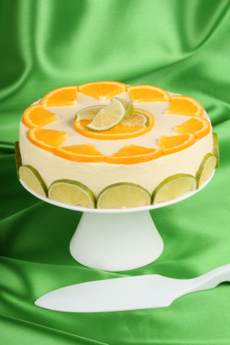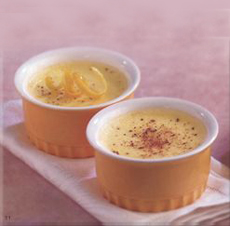Custard Glossary: A Glossary Of The Different Custard TypesPage 1: Custard Terms A To B This is Page 1 of an 1-page article. Click on the red links below to visit other pages. This glossary is protected by copyright and cannot be reproduced in whole or part. You are welcome to link to it.
|
 A modern-style Bavarian cream (the originals were made in fluted molds). Photo by Massimiliano Pieraccini | IST. |
|
| Custard History: Custard as we know it dates back to the Middle Ages, when it was used as a filling for a flan or a tart. The word custard is derived from “crustade,” a tart with a crust. After the 16th century, fruit creams became popular and it was about this time that custards began to be made in individual dishes or bowls rather than as fillings for a crust. Yet, as things move full circle, today custard is used to fill tarts, Danish pastry, flans, cream puffs and éclairs; it is mixed into trifles and oth=p8erwise part of other sweet and savory delights. Custards are prepared in two ways: stirred or cooked on top of the stove, or baked in the oven. The Difference Between Custard & Pudding:
Custard, on the other hand, is an eggy delight that can be either baked or cooked on the stovetop. The egg protein is the thickener. There are hybrids, such as pastry cream (the filling of cream puffs and éclairs).
|
||
| BAIN MARIE or WATER BATH: A technique of baking custard and other delicate, egg-based dishes from cracking or curdling in a hot oven, and to prevent sauces from curdling on the stove. The proteins in the eggs are very heat sensitive and need to be cooked slowly and gently. In this technique, the pie plate, custard cups or other baking container is placed inside a baking pan; simmering hot water is poured up to the level of the filling inside the mold to protect the custard from the heat.
|
 It’s easy to make a bain-marie. Photo courtesy of American Egg Board. |
|
| BAKED CUSTARD: Custard, a mixture of cream and eggs, can be made in either sauce form or baked in a variety of forms, where it becomes thicken and set. Tarts, pies and quiches are examples. In its simplest form, a plain custard is baked in dish, ramekin or custard cup. More elaborated baked custards include crème caramel (flan) and crème brûlée.
|
 Popular in the U.K. for an “instant” custard sauce. Photo courtesy Egg Farmers Of Alberta. |
|
| BAVARIAN CREAM or CRÈME BAVAROIS: A mold of crème anglaise (a rich custard, see photo at top), combined with gelatin, beaten egg whites, and lightly whipped cream. It can be flavored with vanilla, fruit purée, chocolate, liqueur etc., then put into a decorative mold, chilled and unmolded. See photo at the top of the page. The dessert originated in France in the early 19th century. The great chef Marie-Antoine Carême is generally credited for the invention. While the connection to Bavaria is obscure, Carême created great dinners for royalty and others at the top of society, so the dessert may well have been created to honor guests from Bavaria.
|
 Bavarian cream, a dessert fit for a king. Photo by Massimiliano Pieraccini | IST. |
|
| BIEN ME SABE or PUERTO RICAN COCONUT CREAM: Not a true custard, because it uses coconut milk instead of cow’s milk or cream. This popular pudding means “It tastes good to me” in Spanish. The grated meat and milk of a fresh coconut are cooked with egg yolks and sugar to a thick consistency, then flavored with vanilla or rum. It is popularly served over sponge cake, or incorporated into a layered sponge cake with whipped cream, as shown in the photo. Here’s a recipe.
|
 Popular in the U.K. for an “instant” custard sauce. Photo courtesy ImperialSugar.com. |
|
| BIRD’S CUSTARD: An artificially-flavored commercial custard powder, one of the numerous instant and commercial “custards” that are not true custards because they are not thickened with eggs but cornstarch. It was invented by Alfred Bird and Sons Ltd. of Birmingham, England, in 1837. Bird created it because his wife was allergic to eggs, the key ingredient used to thicken traditional custard. Some people prefer using powdered custard sauce because it is much easier to make and there is no concerned with the eggs curdling, the chief challenge of making a traditional custard.
|
 Popular in the U.K. for an “instant” custard sauce. Photo courtesy Bird’s. |
|
|
BLANCMANGE or BLANC MANGE: Blancmange is not a custard but cornstarch pudding; it does not contain eggs, but uses cornstarch as the thickener. French for “white food,” it can be a white or pinkish molded pudding made from milk or almond milk and/or cream, sugar, gelatin or cornstarch and a flavoring, usually almond. The original blancmange used pulverized almonds instead of cornstarch. It can be made in butterscotch and chocolate pudding variations as well. It is pronounced blah-MOHNGE. BOILED CUSTARD:
|
 Blancmange. Photo courtesy Delicious-Cooks.com. |
|
| BREAD PUDDING: Originally a way to use stale bread, cubes or slices of bread are drenched (similar to French toast) with a mixture of milk, eggs, sugar, vanilla and spices—in essence, a custard. The bread-custard pudding can be baked plain, or with any combination of fruits and/or nuts. The dish can be served hot or cold, with or without whipped cream or a sauce, such as hard sauce or custard sauce. Nibble Tip:
|
 Bread pudding. Photo courtesy Between the Bread | NYC.com.  Nutmeg. Photo by Tijmen Van Dobbenburgh | SXC. |
|
Last Updated May 2018
© Copyright 2005-2025 Lifestyle Direct, Inc. All rights reserved. All images are copyrighted to their respective owners.